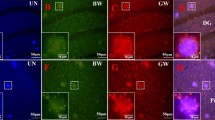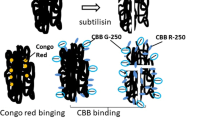Abstract
Thioflavine T (ThT), a fluorescent indicator of amyloid fibrils, has been tested in unfractionated tissue homogenates. With 250nM of ThT, liver homogenates from 17-month-old SAM-P/l (senescence accelerated mouse-prone), which contained amyloid fibrils in murine senile amyloidosis (fASSAM) fluoresced brightly, while normal liver homogenates showed a negligible fluorescence. We determined the concentration of fASSAM in the tissue, from the fluorescence and using the standard curve for fASSAM determination. Lower limits of fASSAM determination were about 1μg/mg tissue. A marked regional heterogeneity of fASSAM deposition was observed in the liver. We observed a linear correlation between fASSAM concentration and percentage of amyloid positive area in the liver. Age dependent increases in fASSAM concentrations and total fASSAM contents were noted in the liver and spleen of 11 to 15-month-old SAM-P/1.
Access this chapter
Tax calculation will be finalised at checkout
Purchases are for personal use only
Preview
Unable to display preview. Download preview PDF.
Similar content being viewed by others
References
Naiki, H., Higuchi, K., Hosokawa, M., and Takeda, T. (1989) ‘Fluorometric determination of amyloid fibrils in vitro using the fluorescent dye, thioflavine T’, Anal. Biochem. 177, 244–249.
Higuchi, K., Matsumura, A., Honma, A., Takeshita, S., Hashimoto, K., Hosokawa, M., Yasuhira, K., and Takeda, T. (1983) ‘Systemic senile amyloid in senescence-accelerated mice’, Lab. Invest. 48, 231–240.
Pras, M., Zucker-Franklin, D., Rimon, A., and Franklin, Edward C. (1969) ‘Physical, chemical, and ultrastructural studies of water-soluble human amyloid fibrils’, J. Exp. Med. 130, 777–791.
Snow, Alan D., Willmer, J., and Kisilevsky, R. (1987) ‘Sulfated glycosaminoglycans: A common constituent of all amyloids?’, Lab. Invest. 56, 120–123.
Author information
Authors and Affiliations
Editor information
Editors and Affiliations
Rights and permissions
Copyright information
© 1991 Springer Science+Business Media Dordrecht
About this chapter
Cite this chapter
Naiki, H. et al. (1991). Fluorometric Examination of Tissue Amyloid Fibrils in Murine Senile Amyloidosis: Use of the Fluorescent Indicator, Thioflavine T. In: Natvig, J.B., et al. Amyloid and Amyloidosis 1990. Springer, Dordrecht. https://doi.org/10.1007/978-94-011-3284-8_99
Download citation
DOI: https://doi.org/10.1007/978-94-011-3284-8_99
Publisher Name: Springer, Dordrecht
Print ISBN: 978-94-010-5450-8
Online ISBN: 978-94-011-3284-8
eBook Packages: Springer Book Archive




